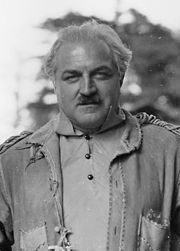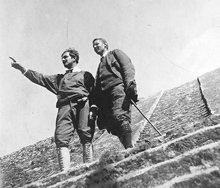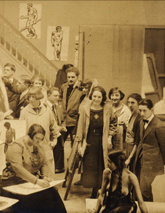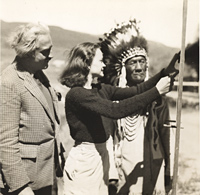 |
| Winold
Reiss, ca. 1934 |
|
Winold Reiss (1886-1953)
Jeffrey C. Stewart
Winold Reiss was a uniquely gifted artist and
designer of the twentieth century, a bold pioneer whose work
included a rich variety of portraits, distinctive interiors,
and a multitude of cutting-edge graphic designs that lifted
the quality of color and black-and-white design in America.
The art of this German immigrant is still being
discovered today by American critics and patrons, but his
public popularity began during the 1920s when his portraits
of the 'New Negroes' in Harlem and his African-inspired designs
were enthusiastically received, along with his portraits of
the Blackfeet and Blood Indians of the American Northwest
and Canada, many of which illustrated the Great Northern Railway
calendars. Reiss believed that by picturing the honor, beauty,
and dignity of all peoples, his art could help break down
racial prejudices and testify to what Johann Wolfgang von
Goethe called the "unity of all creation." His wish
was to use art to change the world.
Born in Karlsruhe, Germany, Winold was the son
of Fritz Reiss, a painter trained at the Düsseldorf Academy,
who made drawing and painting the German landscape and its
peasants his life work. Fritz Reiss was his son's first teacher,
but after that tutelage, Winold went to Munich where he attended
both the Royal Academy of Fine Arts (Kunstakademie),
studying with Franz von Stuck, and the School of Applied Arts
(Kunstgewerbeschule), where he studied with Julius
Diez. He emigrated to America in 1913 and settled in New York
City, where he quickly became well known for his strong, colorful
graphic designs as well as for his modern commercial interiors.
 |
|
Winold Reiss and Dr. Schäffer
in Mexico, 1920
|
Coming to America
also gave Winold the opportunity to meet and paint portraits
of Native Americans, the American Indians who had fascinated
him when as a boy he had read the Wild West stories
of Karl May and the Leatherstocking Tales of James
Fenimore Cooper. In 1920 he traveled to Browning, Montana,
where he drew portraits of Blackfeet elders who had survived
the nineteenth-century struggles for independence, as well
as an emerging generation of native farmers and ranchers in
the subsequent reservation days. In 1920 he went on a six-week
trip to Mexico and drew portraits of the heirs of the Aztecs
and of Mexican revolutionaries.
In 1921 he visited his native Germany on the
only trip he made back to Europe. Here he drew many portraits
of German
and Swedish folk types and colorful characters. After
his return to New York City in 1922, he was chosen by the
editor of the social welfare journal Survey Graphic
to portray the major figures of the Harlem Renaissance for
a special issue entitled Harlem: Mecca of the New Negro
[March 1, 1925]. Dr. Alain Locke, Howard University philosophy
professor and literary critic, was so impressed with Reiss's
portraits that he chose him to illustrate The New Negro:
An Interpretation [1925], the most important anthology
of the Harlem Renaissance. In 1926, Survey Graphic
asked Reiss to illustrate a special Pacific issue with portraits
of Asian
Americans.
Later, in 1927, he portrayed African Americans
living on
St. Helena Island for another Survey Graphic issue.
In the 1920s and 1930s, his trips to Glacier National Park
were financed by the Great Northern Railway, which selected
many of his portraits to illustrate its travel calendars.
Reiss was also a highly successful graphic
designer. His brightly colored covers and illustrations appeared
in Scribner's
Magazine, Survey
Graphic, Opportunity
Magazine, and numerous other publications. In 1915
he co-founded the Society of Modern Art and its magazine,
Modern Art Collector, which he used to introduce
and spread modern design and color usage in the advertising
world. He designed the interiors of numerous commercial establishments,
including the Crillon
Restaurant, Hotel
Alamac, Hotel
St. George, all of the Longchamps
Restaurants in New York City and elsewhere, the Apollo
Theater and the Tavern Club in Chicago, the Hotel President
in Kansas City, and the Hess Brothers Restaurant in Allentown,
Pennsylvania. For the World's
Fair in New York in 1939, he was selected to design the
exterior façade of the Theatre and Concert Building. His most
outstanding commission was for the Cincinnati
Union Terminal, which opened in 1933. There he fused modern
Art Deco design with portraits illustrating the history of
Cincinnati in mosaics that have survived to the present day.
 |
|
Winold Reiss Art School at
4 Christopher Street, New York City, ca. 1920. Detail
of a photograph by Nickolas Muray.
|
Never a loner, Reiss kept a popular and exciting
studio in New York City, which during the 1920s and 1930s
was frequented by artists such as Marion Greenwood, Isamu
Noguchi, Aaron Douglas, Ludwig Bemelmans, and Carl Link, and
intellectuals such as Alain Locke, Jessie Fauset, Paul Kellogg,
and Paul Robeson. He opened his own art school in New York
City, held a summer school in Woodstock, New York, as early
as 1916, and during the 1930s conducted the Winold Reiss
Summer School in Glacier Park, Montana. In 1933, he was
appointed assistant professor of mural painting at New York
University. Reiss died in New York City in 1953.
Reiss himself is just as important as his art,
for he possessed a remarkably open, warm, and infectious personality,
one that allowed him to win the trust and confidence of Blackfeet
Indians, Mexican revolutionaries, and Harlem Black artists
and intellectuals alike. His life and work challenge the categories
by which we normally evaluate and characterize American and
ethnic art in this country. Arriving in America in 1913, Reiss
was inspired by its ethnic diversity and the art produced
by the varied ethnic groups. In his own work he demonstrated
that he could represent a variety of racial and ethnic groups
as objectively and compassionately as if he were one of their
own, breaking through the resistance of some minority communities
to having a white man portray them.
 |
|
Winold Reiss, Aline Davis and Bird
Rattler, Winold Reiss Summer School, Glacier Park, Montana,
1935
|
In some respects, his devotion to drawing and
painting non-white subjects minimized his work within the
American art establishment. His idealism challenges the notion
that as Americans we are anything less than "us,"
a totality that includes rather than excludes.
Viewing and studying the work of Winold Reiss
provide the student and expert with a series of challenges,
for to understand this remarkable German artist, who came
to America with a unique sense of what this country was, is
to challenge our own preconceptions about what American art
is and should be. As such, Winold Reiss was a hero who stuck
to and disseminated a vision of art and its relationship to
the American community that we in the twenty-first century
are still struggling to realize.
Back
to top
|